Impact of Drought on the Queensland Beef Industry: A Research Project
VerifiedAdded on 2023/01/06
|23
|7766
|65
Report
AI Summary
This research project investigates the significant impact of drought on the Queensland beef industry. The report begins with an introduction detailing the industry's importance and the nature of drought, followed by a comprehensive literature review exploring existing research on the topic, including the economic impacts of drought and current mitigation strategies employed within the beef sector. The methodology section outlines the use of secondary data collection and thematic analysis to evaluate existing information. Findings are presented through thematic analysis, addressing the research questions regarding economic impacts, current strategies, and potential alternatives. The report concludes with a summary of findings and offers recommendations for improving drought management and minimizing economic losses within the Queensland beef industry. The study also identifies research gaps and suggests areas for further investigation to enhance the resilience of the beef industry in the face of drought conditions. The executive summary provides an overview of the entire research project.
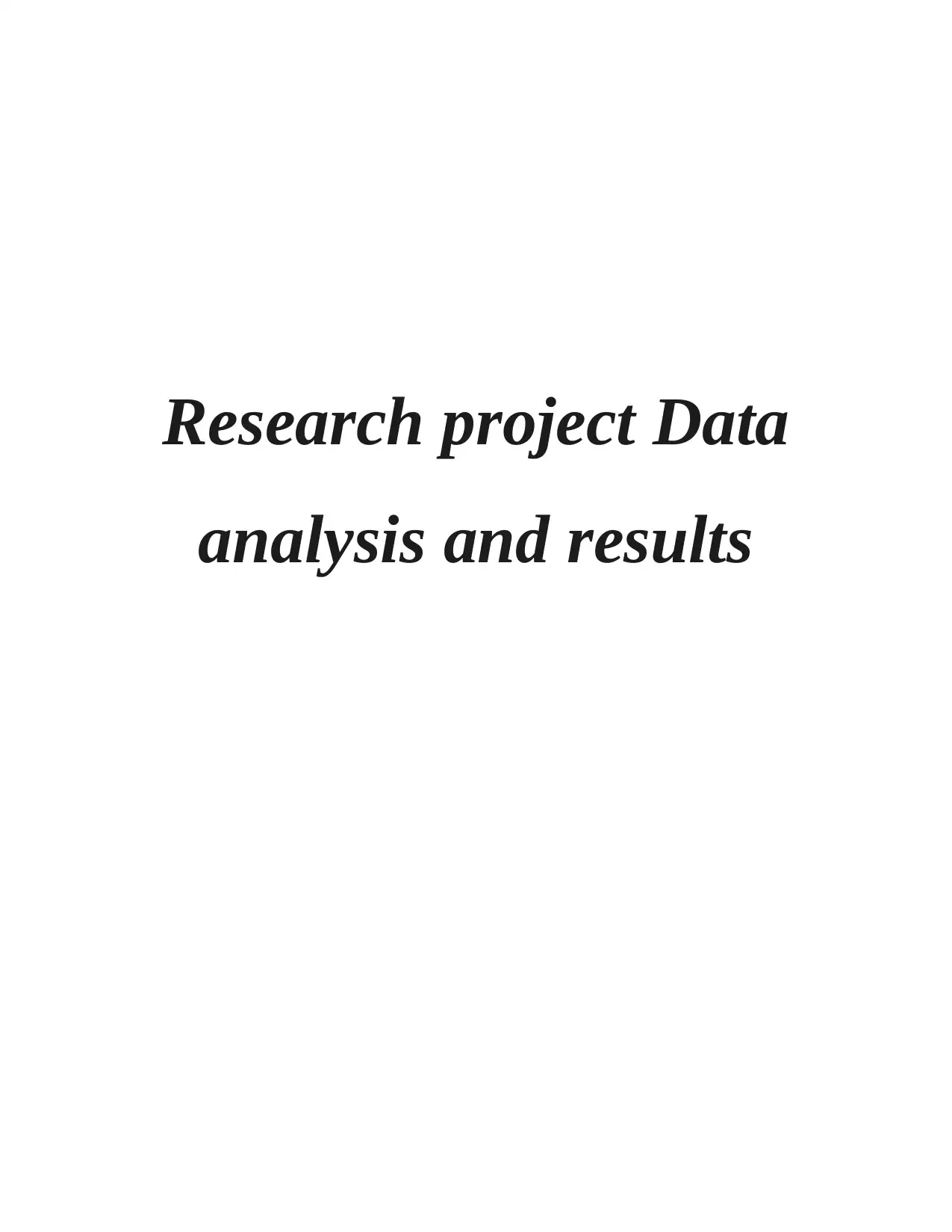
Research project Data
analysis and results
analysis and results
Paraphrase This Document
Need a fresh take? Get an instant paraphrase of this document with our AI Paraphraser
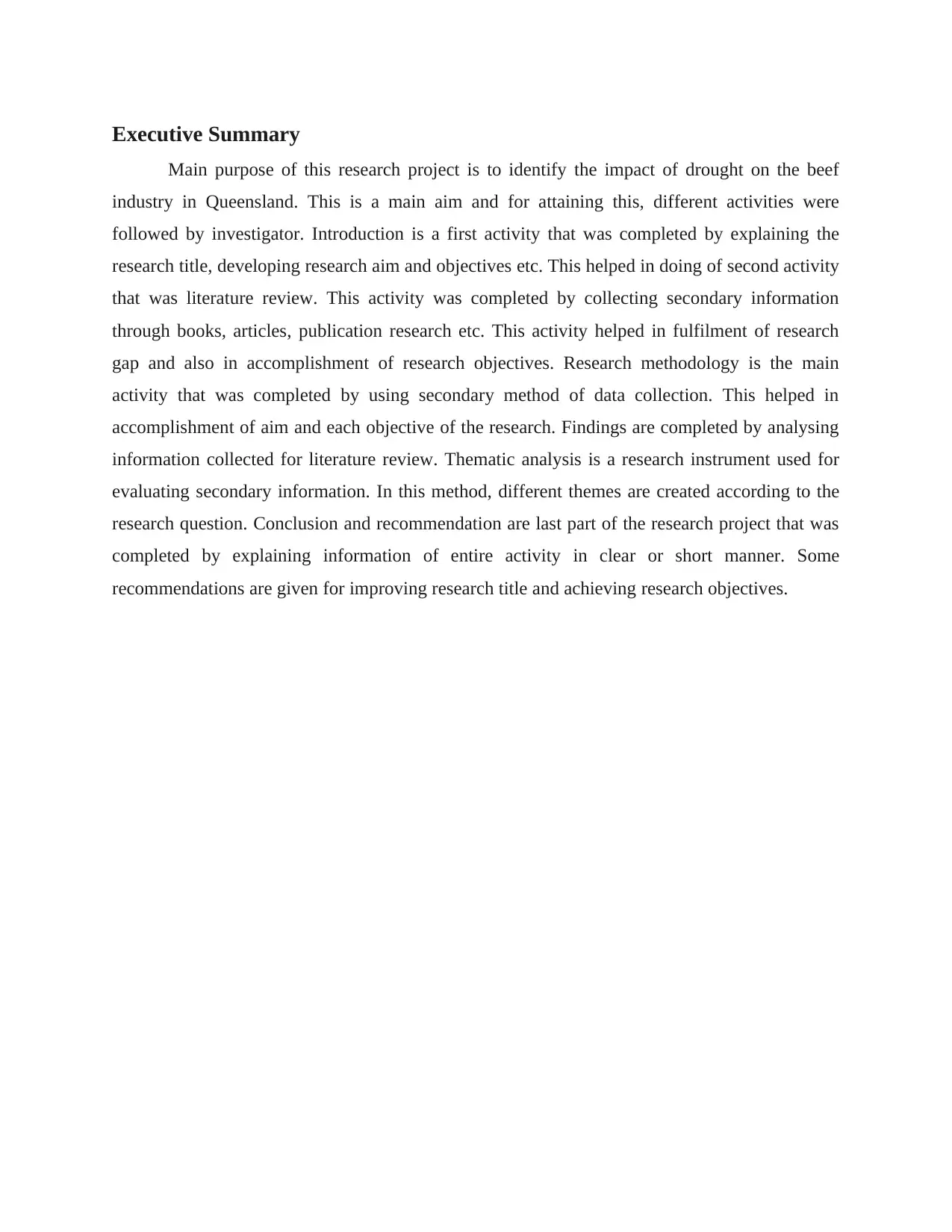
Executive Summary
Main purpose of this research project is to identify the impact of drought on the beef
industry in Queensland. This is a main aim and for attaining this, different activities were
followed by investigator. Introduction is a first activity that was completed by explaining the
research title, developing research aim and objectives etc. This helped in doing of second activity
that was literature review. This activity was completed by collecting secondary information
through books, articles, publication research etc. This activity helped in fulfilment of research
gap and also in accomplishment of research objectives. Research methodology is the main
activity that was completed by using secondary method of data collection. This helped in
accomplishment of aim and each objective of the research. Findings are completed by analysing
information collected for literature review. Thematic analysis is a research instrument used for
evaluating secondary information. In this method, different themes are created according to the
research question. Conclusion and recommendation are last part of the research project that was
completed by explaining information of entire activity in clear or short manner. Some
recommendations are given for improving research title and achieving research objectives.
Main purpose of this research project is to identify the impact of drought on the beef
industry in Queensland. This is a main aim and for attaining this, different activities were
followed by investigator. Introduction is a first activity that was completed by explaining the
research title, developing research aim and objectives etc. This helped in doing of second activity
that was literature review. This activity was completed by collecting secondary information
through books, articles, publication research etc. This activity helped in fulfilment of research
gap and also in accomplishment of research objectives. Research methodology is the main
activity that was completed by using secondary method of data collection. This helped in
accomplishment of aim and each objective of the research. Findings are completed by analysing
information collected for literature review. Thematic analysis is a research instrument used for
evaluating secondary information. In this method, different themes are created according to the
research question. Conclusion and recommendation are last part of the research project that was
completed by explaining information of entire activity in clear or short manner. Some
recommendations are given for improving research title and achieving research objectives.
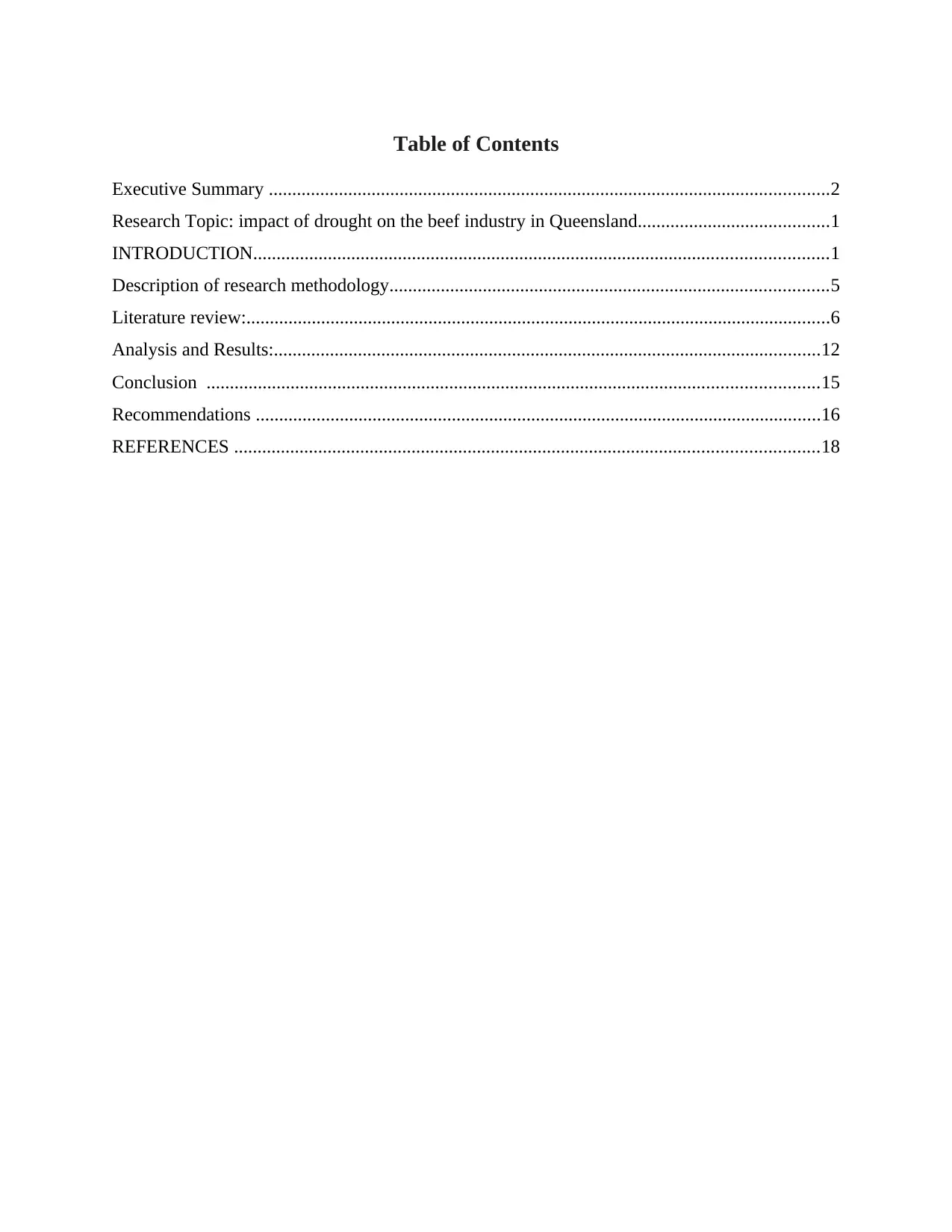
Table of Contents
Executive Summary ........................................................................................................................2
Research Topic: impact of drought on the beef industry in Queensland.........................................1
INTRODUCTION...........................................................................................................................1
Description of research methodology..............................................................................................5
Literature review:.............................................................................................................................6
Analysis and Results:.....................................................................................................................12
Conclusion ...................................................................................................................................15
Recommendations .........................................................................................................................16
REFERENCES .............................................................................................................................18
Executive Summary ........................................................................................................................2
Research Topic: impact of drought on the beef industry in Queensland.........................................1
INTRODUCTION...........................................................................................................................1
Description of research methodology..............................................................................................5
Literature review:.............................................................................................................................6
Analysis and Results:.....................................................................................................................12
Conclusion ...................................................................................................................................15
Recommendations .........................................................................................................................16
REFERENCES .............................................................................................................................18
⊘ This is a preview!⊘
Do you want full access?
Subscribe today to unlock all pages.

Trusted by 1+ million students worldwide
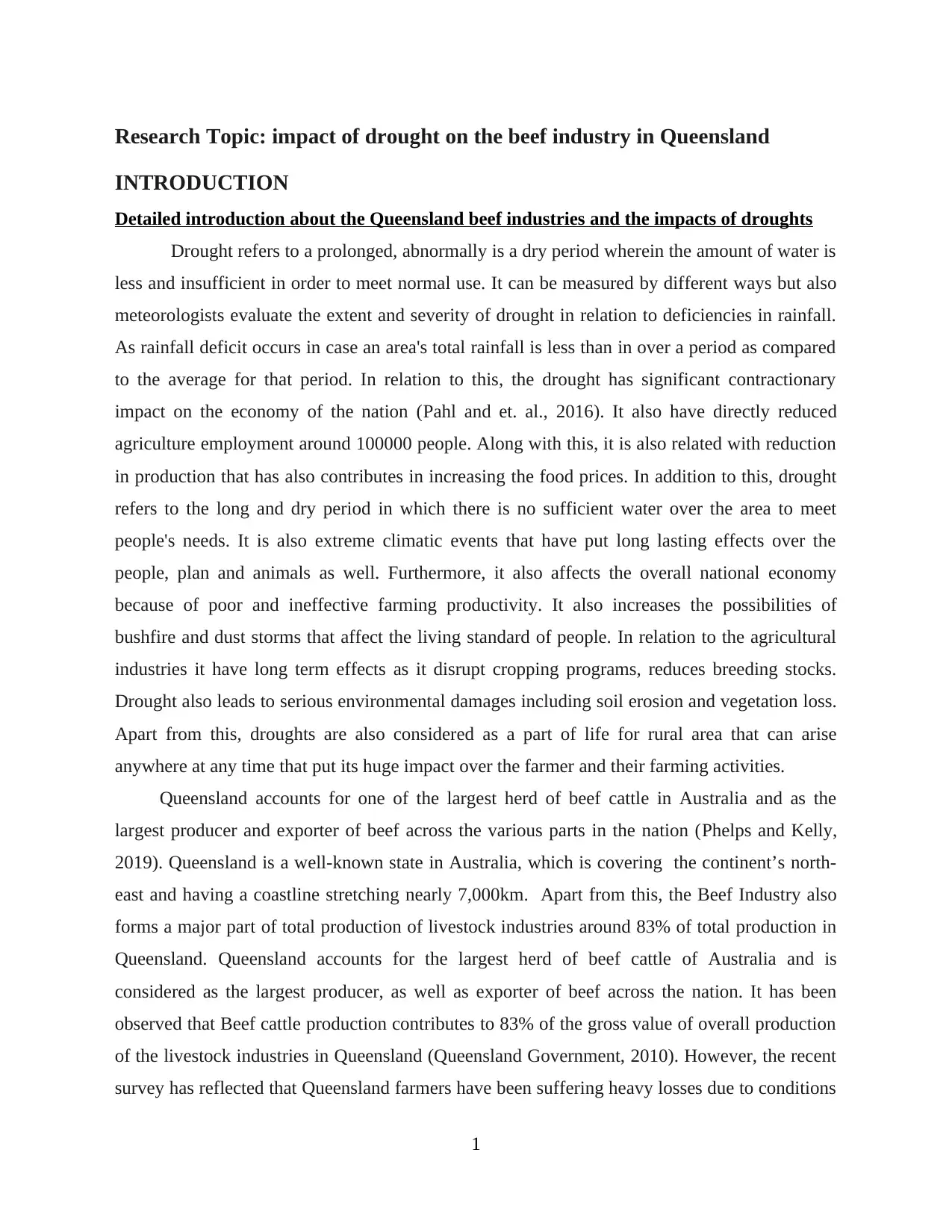
Research Topic: impact of drought on the beef industry in Queensland
INTRODUCTION
Detailed introduction about the Queensland beef industries and the impacts of droughts
Drought refers to a prolonged, abnormally is a dry period wherein the amount of water is
less and insufficient in order to meet normal use. It can be measured by different ways but also
meteorologists evaluate the extent and severity of drought in relation to deficiencies in rainfall.
As rainfall deficit occurs in case an area's total rainfall is less than in over a period as compared
to the average for that period. In relation to this, the drought has significant contractionary
impact on the economy of the nation (Pahl and et. al., 2016). It also have directly reduced
agriculture employment around 100000 people. Along with this, it is also related with reduction
in production that has also contributes in increasing the food prices. In addition to this, drought
refers to the long and dry period in which there is no sufficient water over the area to meet
people's needs. It is also extreme climatic events that have put long lasting effects over the
people, plan and animals as well. Furthermore, it also affects the overall national economy
because of poor and ineffective farming productivity. It also increases the possibilities of
bushfire and dust storms that affect the living standard of people. In relation to the agricultural
industries it have long term effects as it disrupt cropping programs, reduces breeding stocks.
Drought also leads to serious environmental damages including soil erosion and vegetation loss.
Apart from this, droughts are also considered as a part of life for rural area that can arise
anywhere at any time that put its huge impact over the farmer and their farming activities.
Queensland accounts for one of the largest herd of beef cattle in Australia and as the
largest producer and exporter of beef across the various parts in the nation (Phelps and Kelly,
2019). Queensland is a well-known state in Australia, which is covering the continent’s north-
east and having a coastline stretching nearly 7,000km. Apart from this, the Beef Industry also
forms a major part of total production of livestock industries around 83% of total production in
Queensland. Queensland accounts for the largest herd of beef cattle of Australia and is
considered as the largest producer, as well as exporter of beef across the nation. It has been
observed that Beef cattle production contributes to 83% of the gross value of overall production
of the livestock industries in Queensland (Queensland Government, 2010). However, the recent
survey has reflected that Queensland farmers have been suffering heavy losses due to conditions
1
INTRODUCTION
Detailed introduction about the Queensland beef industries and the impacts of droughts
Drought refers to a prolonged, abnormally is a dry period wherein the amount of water is
less and insufficient in order to meet normal use. It can be measured by different ways but also
meteorologists evaluate the extent and severity of drought in relation to deficiencies in rainfall.
As rainfall deficit occurs in case an area's total rainfall is less than in over a period as compared
to the average for that period. In relation to this, the drought has significant contractionary
impact on the economy of the nation (Pahl and et. al., 2016). It also have directly reduced
agriculture employment around 100000 people. Along with this, it is also related with reduction
in production that has also contributes in increasing the food prices. In addition to this, drought
refers to the long and dry period in which there is no sufficient water over the area to meet
people's needs. It is also extreme climatic events that have put long lasting effects over the
people, plan and animals as well. Furthermore, it also affects the overall national economy
because of poor and ineffective farming productivity. It also increases the possibilities of
bushfire and dust storms that affect the living standard of people. In relation to the agricultural
industries it have long term effects as it disrupt cropping programs, reduces breeding stocks.
Drought also leads to serious environmental damages including soil erosion and vegetation loss.
Apart from this, droughts are also considered as a part of life for rural area that can arise
anywhere at any time that put its huge impact over the farmer and their farming activities.
Queensland accounts for one of the largest herd of beef cattle in Australia and as the
largest producer and exporter of beef across the various parts in the nation (Phelps and Kelly,
2019). Queensland is a well-known state in Australia, which is covering the continent’s north-
east and having a coastline stretching nearly 7,000km. Apart from this, the Beef Industry also
forms a major part of total production of livestock industries around 83% of total production in
Queensland. Queensland accounts for the largest herd of beef cattle of Australia and is
considered as the largest producer, as well as exporter of beef across the nation. It has been
observed that Beef cattle production contributes to 83% of the gross value of overall production
of the livestock industries in Queensland (Queensland Government, 2010). However, the recent
survey has reflected that Queensland farmers have been suffering heavy losses due to conditions
1
Paraphrase This Document
Need a fresh take? Get an instant paraphrase of this document with our AI Paraphraser
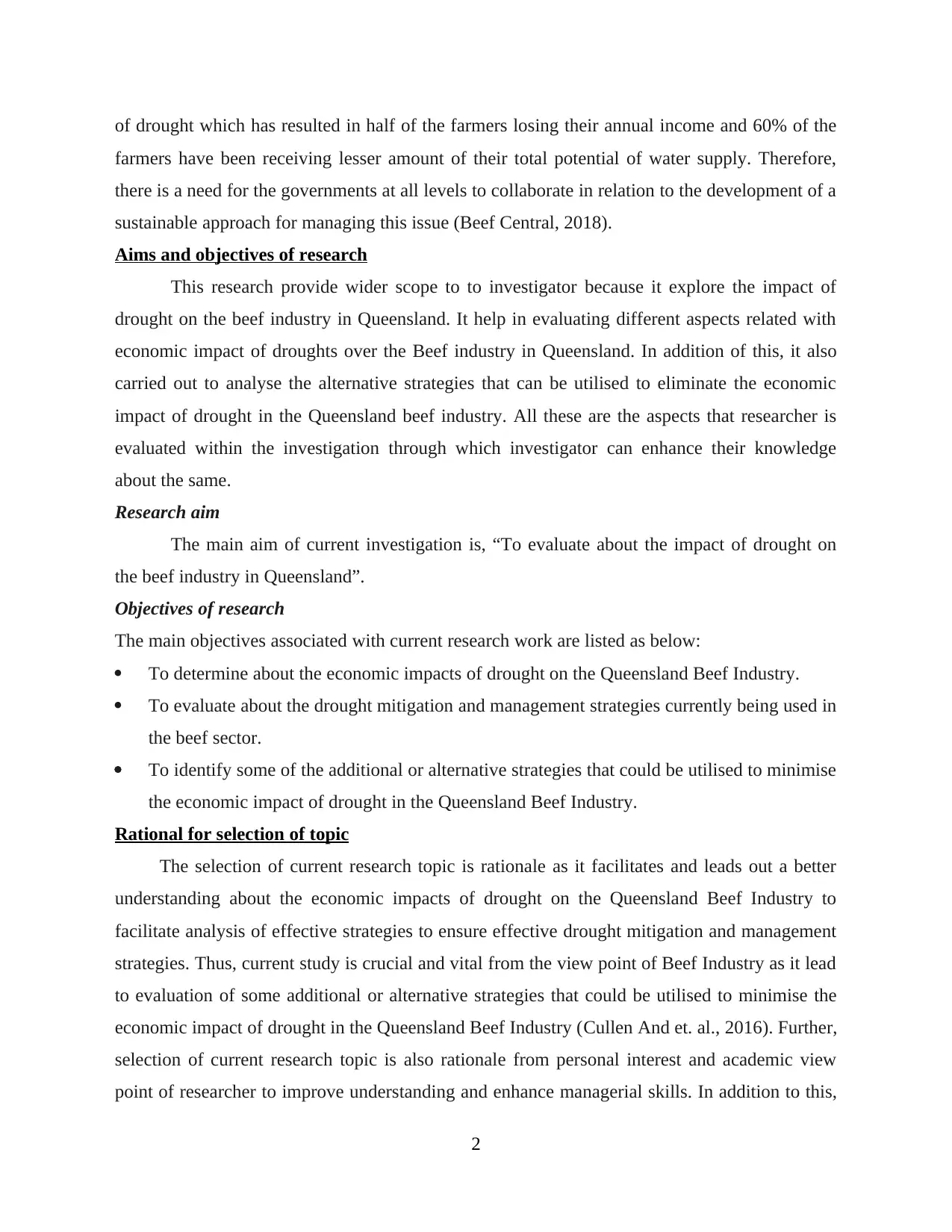
of drought which has resulted in half of the farmers losing their annual income and 60% of the
farmers have been receiving lesser amount of their total potential of water supply. Therefore,
there is a need for the governments at all levels to collaborate in relation to the development of a
sustainable approach for managing this issue (Beef Central, 2018).
Aims and objectives of research
This research provide wider scope to to investigator because it explore the impact of
drought on the beef industry in Queensland. It help in evaluating different aspects related with
economic impact of droughts over the Beef industry in Queensland. In addition of this, it also
carried out to analyse the alternative strategies that can be utilised to eliminate the economic
impact of drought in the Queensland beef industry. All these are the aspects that researcher is
evaluated within the investigation through which investigator can enhance their knowledge
about the same.
Research aim
The main aim of current investigation is, “To evaluate about the impact of drought on
the beef industry in Queensland”.
Objectives of research
The main objectives associated with current research work are listed as below:
To determine about the economic impacts of drought on the Queensland Beef Industry.
To evaluate about the drought mitigation and management strategies currently being used in
the beef sector.
To identify some of the additional or alternative strategies that could be utilised to minimise
the economic impact of drought in the Queensland Beef Industry.
Rational for selection of topic
The selection of current research topic is rationale as it facilitates and leads out a better
understanding about the economic impacts of drought on the Queensland Beef Industry to
facilitate analysis of effective strategies to ensure effective drought mitigation and management
strategies. Thus, current study is crucial and vital from the view point of Beef Industry as it lead
to evaluation of some additional or alternative strategies that could be utilised to minimise the
economic impact of drought in the Queensland Beef Industry (Cullen And et. al., 2016). Further,
selection of current research topic is also rationale from personal interest and academic view
point of researcher to improve understanding and enhance managerial skills. In addition to this,
2
farmers have been receiving lesser amount of their total potential of water supply. Therefore,
there is a need for the governments at all levels to collaborate in relation to the development of a
sustainable approach for managing this issue (Beef Central, 2018).
Aims and objectives of research
This research provide wider scope to to investigator because it explore the impact of
drought on the beef industry in Queensland. It help in evaluating different aspects related with
economic impact of droughts over the Beef industry in Queensland. In addition of this, it also
carried out to analyse the alternative strategies that can be utilised to eliminate the economic
impact of drought in the Queensland beef industry. All these are the aspects that researcher is
evaluated within the investigation through which investigator can enhance their knowledge
about the same.
Research aim
The main aim of current investigation is, “To evaluate about the impact of drought on
the beef industry in Queensland”.
Objectives of research
The main objectives associated with current research work are listed as below:
To determine about the economic impacts of drought on the Queensland Beef Industry.
To evaluate about the drought mitigation and management strategies currently being used in
the beef sector.
To identify some of the additional or alternative strategies that could be utilised to minimise
the economic impact of drought in the Queensland Beef Industry.
Rational for selection of topic
The selection of current research topic is rationale as it facilitates and leads out a better
understanding about the economic impacts of drought on the Queensland Beef Industry to
facilitate analysis of effective strategies to ensure effective drought mitigation and management
strategies. Thus, current study is crucial and vital from the view point of Beef Industry as it lead
to evaluation of some additional or alternative strategies that could be utilised to minimise the
economic impact of drought in the Queensland Beef Industry (Cullen And et. al., 2016). Further,
selection of current research topic is also rationale from personal interest and academic view
point of researcher to improve understanding and enhance managerial skills. In addition to this,
2
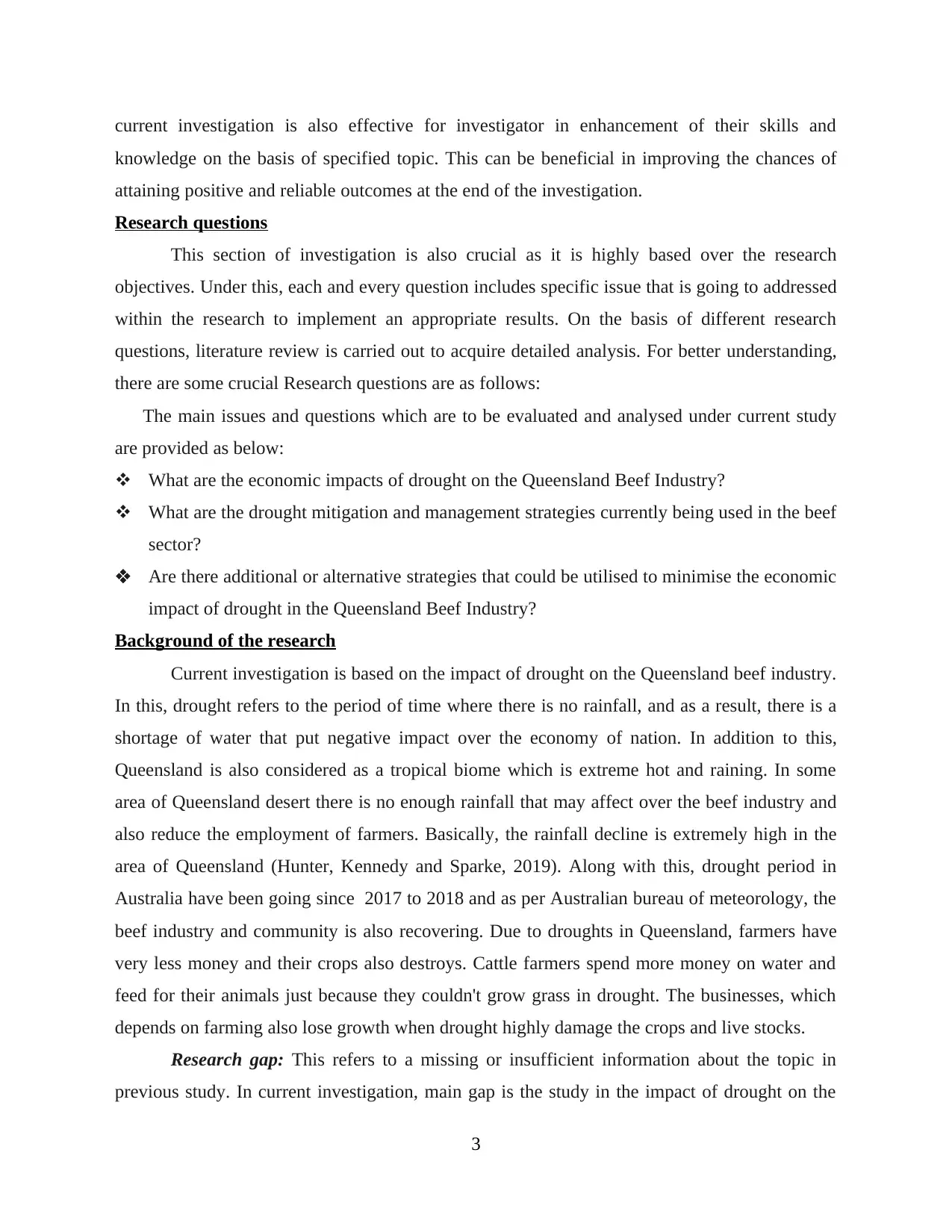
current investigation is also effective for investigator in enhancement of their skills and
knowledge on the basis of specified topic. This can be beneficial in improving the chances of
attaining positive and reliable outcomes at the end of the investigation.
Research questions
This section of investigation is also crucial as it is highly based over the research
objectives. Under this, each and every question includes specific issue that is going to addressed
within the research to implement an appropriate results. On the basis of different research
questions, literature review is carried out to acquire detailed analysis. For better understanding,
there are some crucial Research questions are as follows:
The main issues and questions which are to be evaluated and analysed under current study
are provided as below:
What are the economic impacts of drought on the Queensland Beef Industry?
What are the drought mitigation and management strategies currently being used in the beef
sector?
Are there additional or alternative strategies that could be utilised to minimise the economic
impact of drought in the Queensland Beef Industry?
Background of the research
Current investigation is based on the impact of drought on the Queensland beef industry.
In this, drought refers to the period of time where there is no rainfall, and as a result, there is a
shortage of water that put negative impact over the economy of nation. In addition to this,
Queensland is also considered as a tropical biome which is extreme hot and raining. In some
area of Queensland desert there is no enough rainfall that may affect over the beef industry and
also reduce the employment of farmers. Basically, the rainfall decline is extremely high in the
area of Queensland (Hunter, Kennedy and Sparke, 2019). Along with this, drought period in
Australia have been going since 2017 to 2018 and as per Australian bureau of meteorology, the
beef industry and community is also recovering. Due to droughts in Queensland, farmers have
very less money and their crops also destroys. Cattle farmers spend more money on water and
feed for their animals just because they couldn't grow grass in drought. The businesses, which
depends on farming also lose growth when drought highly damage the crops and live stocks.
Research gap: This refers to a missing or insufficient information about the topic in
previous study. In current investigation, main gap is the study in the impact of drought on the
3
knowledge on the basis of specified topic. This can be beneficial in improving the chances of
attaining positive and reliable outcomes at the end of the investigation.
Research questions
This section of investigation is also crucial as it is highly based over the research
objectives. Under this, each and every question includes specific issue that is going to addressed
within the research to implement an appropriate results. On the basis of different research
questions, literature review is carried out to acquire detailed analysis. For better understanding,
there are some crucial Research questions are as follows:
The main issues and questions which are to be evaluated and analysed under current study
are provided as below:
What are the economic impacts of drought on the Queensland Beef Industry?
What are the drought mitigation and management strategies currently being used in the beef
sector?
Are there additional or alternative strategies that could be utilised to minimise the economic
impact of drought in the Queensland Beef Industry?
Background of the research
Current investigation is based on the impact of drought on the Queensland beef industry.
In this, drought refers to the period of time where there is no rainfall, and as a result, there is a
shortage of water that put negative impact over the economy of nation. In addition to this,
Queensland is also considered as a tropical biome which is extreme hot and raining. In some
area of Queensland desert there is no enough rainfall that may affect over the beef industry and
also reduce the employment of farmers. Basically, the rainfall decline is extremely high in the
area of Queensland (Hunter, Kennedy and Sparke, 2019). Along with this, drought period in
Australia have been going since 2017 to 2018 and as per Australian bureau of meteorology, the
beef industry and community is also recovering. Due to droughts in Queensland, farmers have
very less money and their crops also destroys. Cattle farmers spend more money on water and
feed for their animals just because they couldn't grow grass in drought. The businesses, which
depends on farming also lose growth when drought highly damage the crops and live stocks.
Research gap: This refers to a missing or insufficient information about the topic in
previous study. In current investigation, main gap is the study in the impact of drought on the
3
⊘ This is a preview!⊘
Do you want full access?
Subscribe today to unlock all pages.

Trusted by 1+ million students worldwide
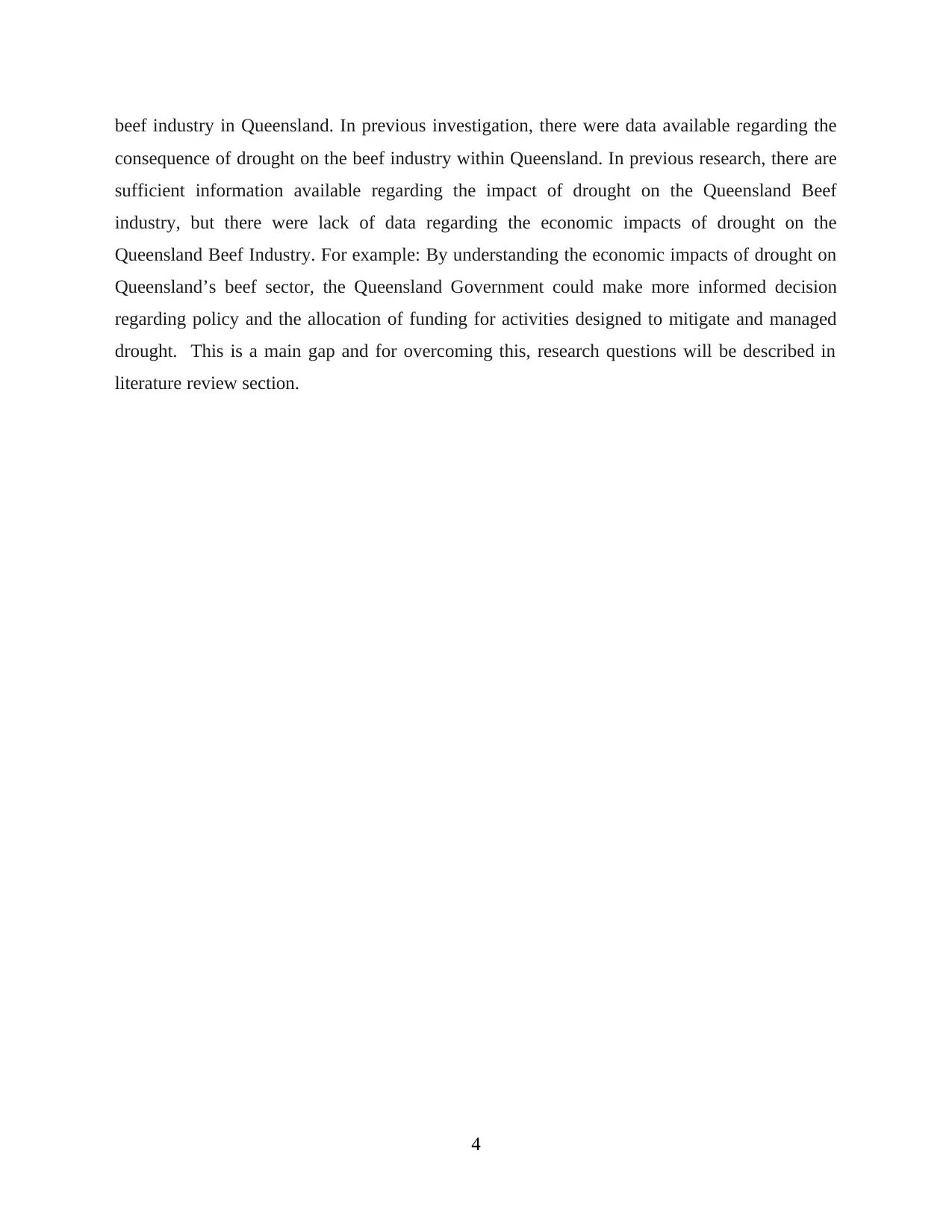
beef industry in Queensland. In previous investigation, there were data available regarding the
consequence of drought on the beef industry within Queensland. In previous research, there are
sufficient information available regarding the impact of drought on the Queensland Beef
industry, but there were lack of data regarding the economic impacts of drought on the
Queensland Beef Industry. For example: By understanding the economic impacts of drought on
Queensland’s beef sector, the Queensland Government could make more informed decision
regarding policy and the allocation of funding for activities designed to mitigate and managed
drought. This is a main gap and for overcoming this, research questions will be described in
literature review section.
4
consequence of drought on the beef industry within Queensland. In previous research, there are
sufficient information available regarding the impact of drought on the Queensland Beef
industry, but there were lack of data regarding the economic impacts of drought on the
Queensland Beef Industry. For example: By understanding the economic impacts of drought on
Queensland’s beef sector, the Queensland Government could make more informed decision
regarding policy and the allocation of funding for activities designed to mitigate and managed
drought. This is a main gap and for overcoming this, research questions will be described in
literature review section.
4
Paraphrase This Document
Need a fresh take? Get an instant paraphrase of this document with our AI Paraphraser
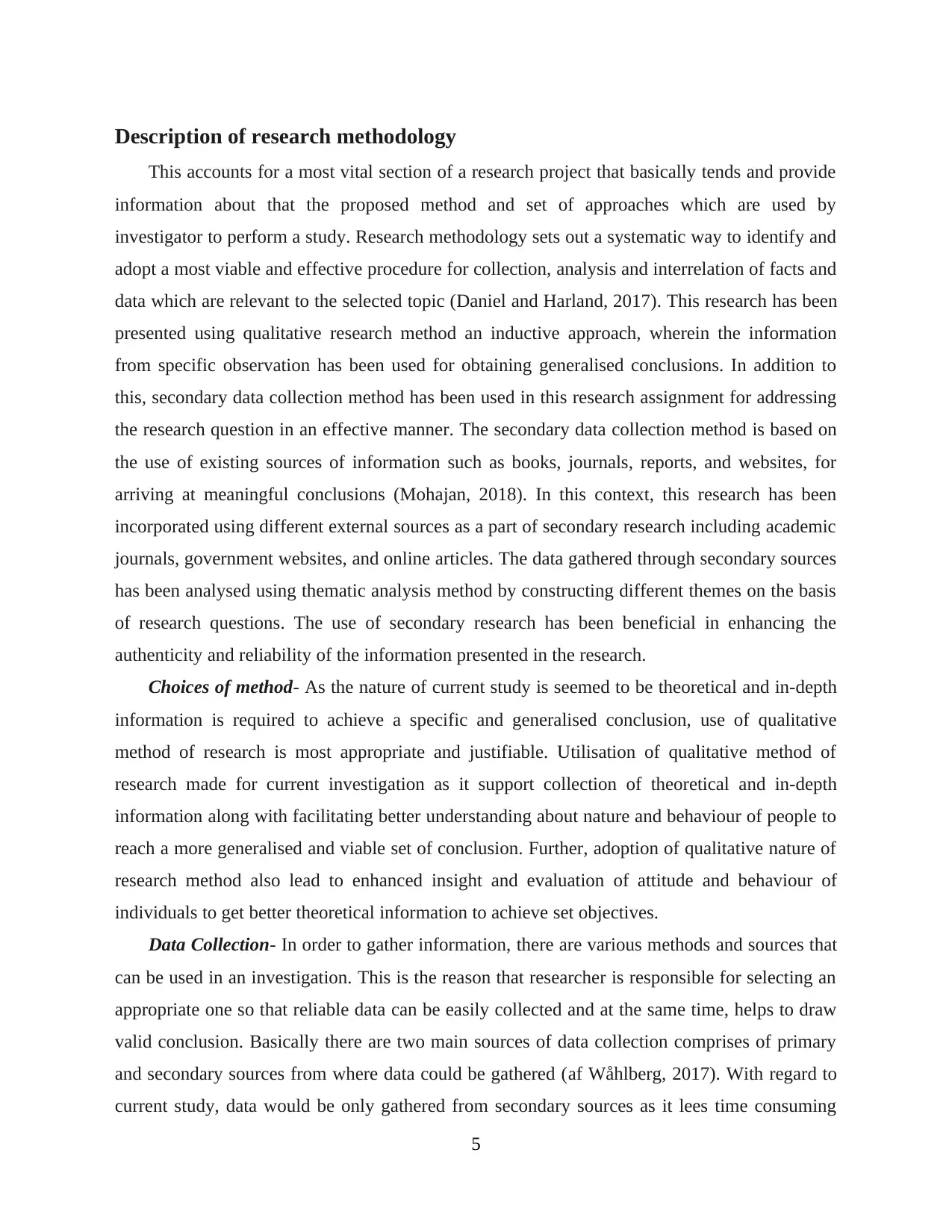
Description of research methodology
This accounts for a most vital section of a research project that basically tends and provide
information about that the proposed method and set of approaches which are used by
investigator to perform a study. Research methodology sets out a systematic way to identify and
adopt a most viable and effective procedure for collection, analysis and interrelation of facts and
data which are relevant to the selected topic (Daniel and Harland, 2017). This research has been
presented using qualitative research method an inductive approach, wherein the information
from specific observation has been used for obtaining generalised conclusions. In addition to
this, secondary data collection method has been used in this research assignment for addressing
the research question in an effective manner. The secondary data collection method is based on
the use of existing sources of information such as books, journals, reports, and websites, for
arriving at meaningful conclusions (Mohajan, 2018). In this context, this research has been
incorporated using different external sources as a part of secondary research including academic
journals, government websites, and online articles. The data gathered through secondary sources
has been analysed using thematic analysis method by constructing different themes on the basis
of research questions. The use of secondary research has been beneficial in enhancing the
authenticity and reliability of the information presented in the research.
Choices of method- As the nature of current study is seemed to be theoretical and in-depth
information is required to achieve a specific and generalised conclusion, use of qualitative
method of research is most appropriate and justifiable. Utilisation of qualitative method of
research made for current investigation as it support collection of theoretical and in-depth
information along with facilitating better understanding about nature and behaviour of people to
reach a more generalised and viable set of conclusion. Further, adoption of qualitative nature of
research method also lead to enhanced insight and evaluation of attitude and behaviour of
individuals to get better theoretical information to achieve set objectives.
Data Collection- In order to gather information, there are various methods and sources that
can be used in an investigation. This is the reason that researcher is responsible for selecting an
appropriate one so that reliable data can be easily collected and at the same time, helps to draw
valid conclusion. Basically there are two main sources of data collection comprises of primary
and secondary sources from where data could be gathered (af Wåhlberg, 2017). With regard to
current study, data would be only gathered from secondary sources as it lees time consuming
5
This accounts for a most vital section of a research project that basically tends and provide
information about that the proposed method and set of approaches which are used by
investigator to perform a study. Research methodology sets out a systematic way to identify and
adopt a most viable and effective procedure for collection, analysis and interrelation of facts and
data which are relevant to the selected topic (Daniel and Harland, 2017). This research has been
presented using qualitative research method an inductive approach, wherein the information
from specific observation has been used for obtaining generalised conclusions. In addition to
this, secondary data collection method has been used in this research assignment for addressing
the research question in an effective manner. The secondary data collection method is based on
the use of existing sources of information such as books, journals, reports, and websites, for
arriving at meaningful conclusions (Mohajan, 2018). In this context, this research has been
incorporated using different external sources as a part of secondary research including academic
journals, government websites, and online articles. The data gathered through secondary sources
has been analysed using thematic analysis method by constructing different themes on the basis
of research questions. The use of secondary research has been beneficial in enhancing the
authenticity and reliability of the information presented in the research.
Choices of method- As the nature of current study is seemed to be theoretical and in-depth
information is required to achieve a specific and generalised conclusion, use of qualitative
method of research is most appropriate and justifiable. Utilisation of qualitative method of
research made for current investigation as it support collection of theoretical and in-depth
information along with facilitating better understanding about nature and behaviour of people to
reach a more generalised and viable set of conclusion. Further, adoption of qualitative nature of
research method also lead to enhanced insight and evaluation of attitude and behaviour of
individuals to get better theoretical information to achieve set objectives.
Data Collection- In order to gather information, there are various methods and sources that
can be used in an investigation. This is the reason that researcher is responsible for selecting an
appropriate one so that reliable data can be easily collected and at the same time, helps to draw
valid conclusion. Basically there are two main sources of data collection comprises of primary
and secondary sources from where data could be gathered (af Wåhlberg, 2017). With regard to
current study, data would be only gathered from secondary sources as it lees time consuming
5
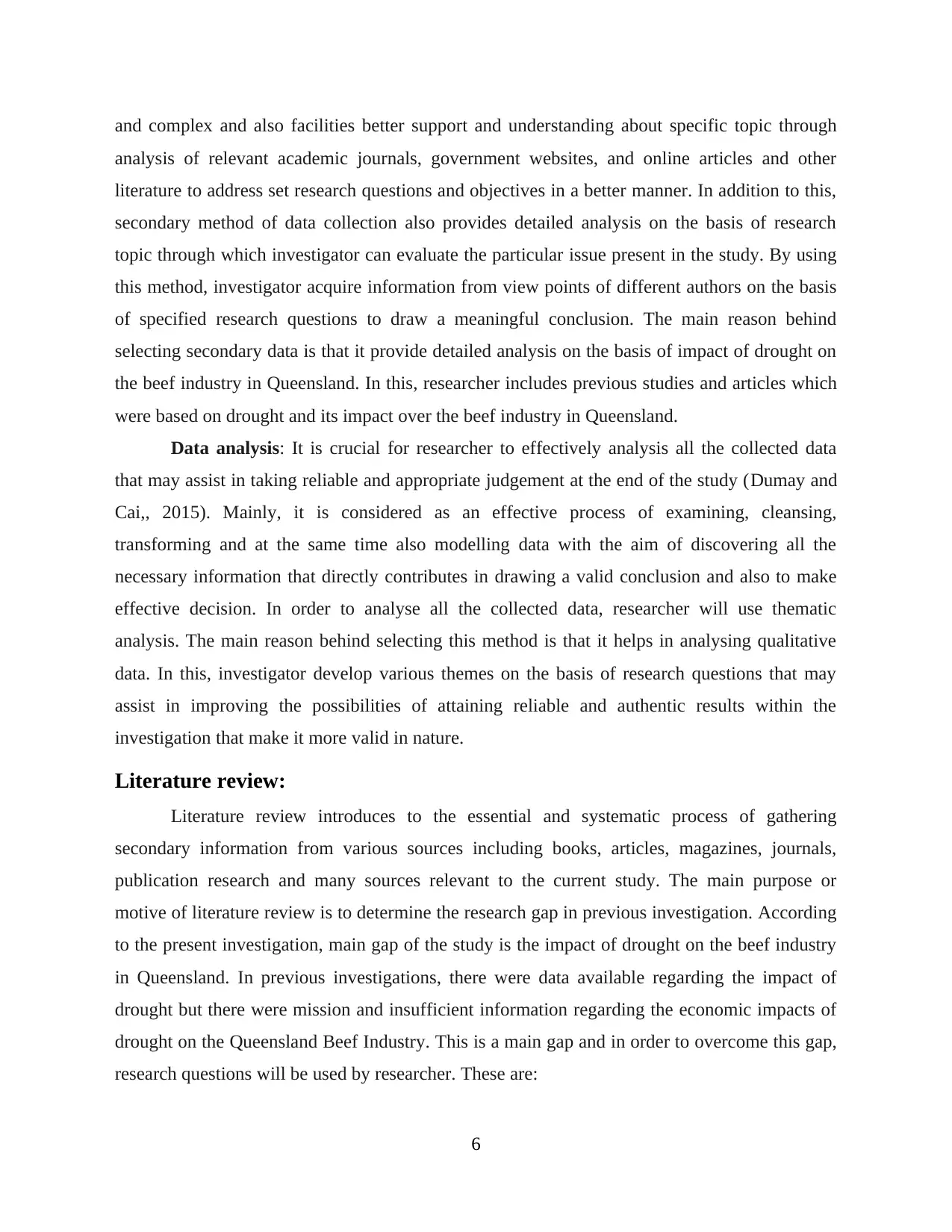
and complex and also facilities better support and understanding about specific topic through
analysis of relevant academic journals, government websites, and online articles and other
literature to address set research questions and objectives in a better manner. In addition to this,
secondary method of data collection also provides detailed analysis on the basis of research
topic through which investigator can evaluate the particular issue present in the study. By using
this method, investigator acquire information from view points of different authors on the basis
of specified research questions to draw a meaningful conclusion. The main reason behind
selecting secondary data is that it provide detailed analysis on the basis of impact of drought on
the beef industry in Queensland. In this, researcher includes previous studies and articles which
were based on drought and its impact over the beef industry in Queensland.
Data analysis: It is crucial for researcher to effectively analysis all the collected data
that may assist in taking reliable and appropriate judgement at the end of the study (Dumay and
Cai,, 2015). Mainly, it is considered as an effective process of examining, cleansing,
transforming and at the same time also modelling data with the aim of discovering all the
necessary information that directly contributes in drawing a valid conclusion and also to make
effective decision. In order to analyse all the collected data, researcher will use thematic
analysis. The main reason behind selecting this method is that it helps in analysing qualitative
data. In this, investigator develop various themes on the basis of research questions that may
assist in improving the possibilities of attaining reliable and authentic results within the
investigation that make it more valid in nature.
Literature review:
Literature review introduces to the essential and systematic process of gathering
secondary information from various sources including books, articles, magazines, journals,
publication research and many sources relevant to the current study. The main purpose or
motive of literature review is to determine the research gap in previous investigation. According
to the present investigation, main gap of the study is the impact of drought on the beef industry
in Queensland. In previous investigations, there were data available regarding the impact of
drought but there were mission and insufficient information regarding the economic impacts of
drought on the Queensland Beef Industry. This is a main gap and in order to overcome this gap,
research questions will be used by researcher. These are:
6
analysis of relevant academic journals, government websites, and online articles and other
literature to address set research questions and objectives in a better manner. In addition to this,
secondary method of data collection also provides detailed analysis on the basis of research
topic through which investigator can evaluate the particular issue present in the study. By using
this method, investigator acquire information from view points of different authors on the basis
of specified research questions to draw a meaningful conclusion. The main reason behind
selecting secondary data is that it provide detailed analysis on the basis of impact of drought on
the beef industry in Queensland. In this, researcher includes previous studies and articles which
were based on drought and its impact over the beef industry in Queensland.
Data analysis: It is crucial for researcher to effectively analysis all the collected data
that may assist in taking reliable and appropriate judgement at the end of the study (Dumay and
Cai,, 2015). Mainly, it is considered as an effective process of examining, cleansing,
transforming and at the same time also modelling data with the aim of discovering all the
necessary information that directly contributes in drawing a valid conclusion and also to make
effective decision. In order to analyse all the collected data, researcher will use thematic
analysis. The main reason behind selecting this method is that it helps in analysing qualitative
data. In this, investigator develop various themes on the basis of research questions that may
assist in improving the possibilities of attaining reliable and authentic results within the
investigation that make it more valid in nature.
Literature review:
Literature review introduces to the essential and systematic process of gathering
secondary information from various sources including books, articles, magazines, journals,
publication research and many sources relevant to the current study. The main purpose or
motive of literature review is to determine the research gap in previous investigation. According
to the present investigation, main gap of the study is the impact of drought on the beef industry
in Queensland. In previous investigations, there were data available regarding the impact of
drought but there were mission and insufficient information regarding the economic impacts of
drought on the Queensland Beef Industry. This is a main gap and in order to overcome this gap,
research questions will be used by researcher. These are:
6
⊘ This is a preview!⊘
Do you want full access?
Subscribe today to unlock all pages.

Trusted by 1+ million students worldwide
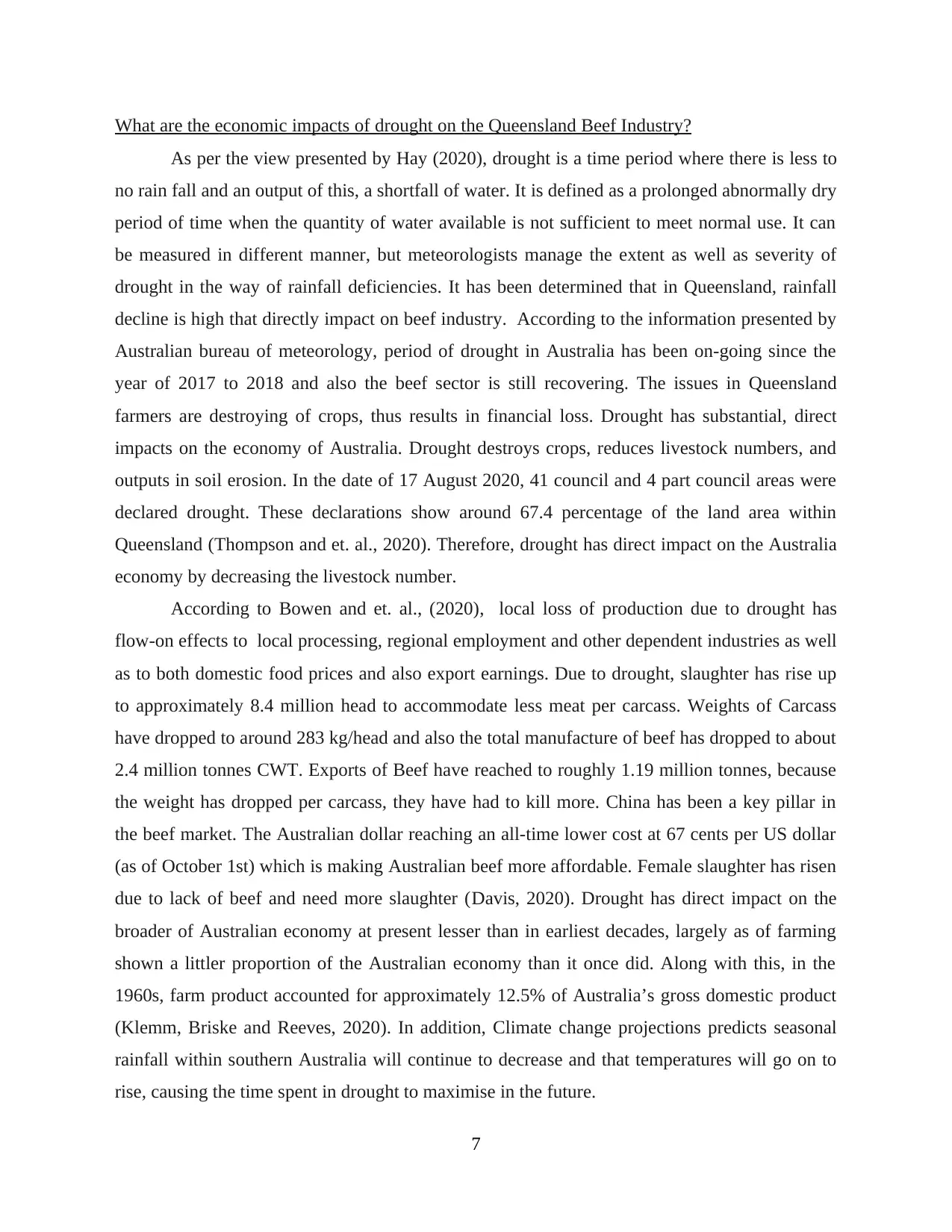
What are the economic impacts of drought on the Queensland Beef Industry?
As per the view presented by Hay (2020), drought is a time period where there is less to
no rain fall and an output of this, a shortfall of water. It is defined as a prolonged abnormally dry
period of time when the quantity of water available is not sufficient to meet normal use. It can
be measured in different manner, but meteorologists manage the extent as well as severity of
drought in the way of rainfall deficiencies. It has been determined that in Queensland, rainfall
decline is high that directly impact on beef industry. According to the information presented by
Australian bureau of meteorology, period of drought in Australia has been on-going since the
year of 2017 to 2018 and also the beef sector is still recovering. The issues in Queensland
farmers are destroying of crops, thus results in financial loss. Drought has substantial, direct
impacts on the economy of Australia. Drought destroys crops, reduces livestock numbers, and
outputs in soil erosion. In the date of 17 August 2020, 41 council and 4 part council areas were
declared drought. These declarations show around 67.4 percentage of the land area within
Queensland (Thompson and et. al., 2020). Therefore, drought has direct impact on the Australia
economy by decreasing the livestock number.
According to Bowen and et. al., (2020), local loss of production due to drought has
flow-on effects to local processing, regional employment and other dependent industries as well
as to both domestic food prices and also export earnings. Due to drought, slaughter has rise up
to approximately 8.4 million head to accommodate less meat per carcass. Weights of Carcass
have dropped to around 283 kg/head and also the total manufacture of beef has dropped to about
2.4 million tonnes CWT. Exports of Beef have reached to roughly 1.19 million tonnes, because
the weight has dropped per carcass, they have had to kill more. China has been a key pillar in
the beef market. The Australian dollar reaching an all-time lower cost at 67 cents per US dollar
(as of October 1st) which is making Australian beef more affordable. Female slaughter has risen
due to lack of beef and need more slaughter (Davis, 2020). Drought has direct impact on the
broader of Australian economy at present lesser than in earliest decades, largely as of farming
shown a littler proportion of the Australian economy than it once did. Along with this, in the
1960s, farm product accounted for approximately 12.5% of Australia’s gross domestic product
(Klemm, Briske and Reeves, 2020). In addition, Climate change projections predicts seasonal
rainfall within southern Australia will continue to decrease and that temperatures will go on to
rise, causing the time spent in drought to maximise in the future.
7
As per the view presented by Hay (2020), drought is a time period where there is less to
no rain fall and an output of this, a shortfall of water. It is defined as a prolonged abnormally dry
period of time when the quantity of water available is not sufficient to meet normal use. It can
be measured in different manner, but meteorologists manage the extent as well as severity of
drought in the way of rainfall deficiencies. It has been determined that in Queensland, rainfall
decline is high that directly impact on beef industry. According to the information presented by
Australian bureau of meteorology, period of drought in Australia has been on-going since the
year of 2017 to 2018 and also the beef sector is still recovering. The issues in Queensland
farmers are destroying of crops, thus results in financial loss. Drought has substantial, direct
impacts on the economy of Australia. Drought destroys crops, reduces livestock numbers, and
outputs in soil erosion. In the date of 17 August 2020, 41 council and 4 part council areas were
declared drought. These declarations show around 67.4 percentage of the land area within
Queensland (Thompson and et. al., 2020). Therefore, drought has direct impact on the Australia
economy by decreasing the livestock number.
According to Bowen and et. al., (2020), local loss of production due to drought has
flow-on effects to local processing, regional employment and other dependent industries as well
as to both domestic food prices and also export earnings. Due to drought, slaughter has rise up
to approximately 8.4 million head to accommodate less meat per carcass. Weights of Carcass
have dropped to around 283 kg/head and also the total manufacture of beef has dropped to about
2.4 million tonnes CWT. Exports of Beef have reached to roughly 1.19 million tonnes, because
the weight has dropped per carcass, they have had to kill more. China has been a key pillar in
the beef market. The Australian dollar reaching an all-time lower cost at 67 cents per US dollar
(as of October 1st) which is making Australian beef more affordable. Female slaughter has risen
due to lack of beef and need more slaughter (Davis, 2020). Drought has direct impact on the
broader of Australian economy at present lesser than in earliest decades, largely as of farming
shown a littler proportion of the Australian economy than it once did. Along with this, in the
1960s, farm product accounted for approximately 12.5% of Australia’s gross domestic product
(Klemm, Briske and Reeves, 2020). In addition, Climate change projections predicts seasonal
rainfall within southern Australia will continue to decrease and that temperatures will go on to
rise, causing the time spent in drought to maximise in the future.
7
Paraphrase This Document
Need a fresh take? Get an instant paraphrase of this document with our AI Paraphraser
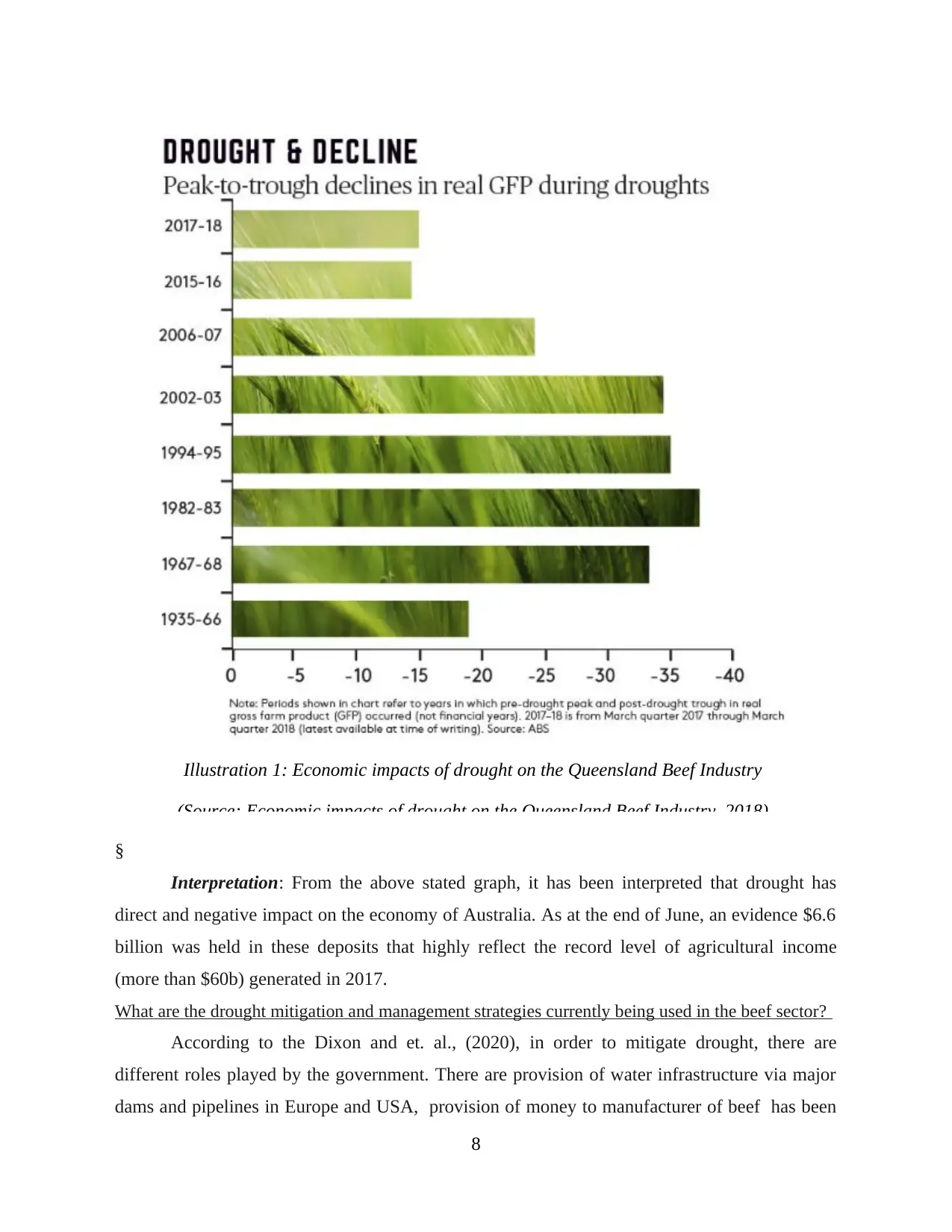
Illustration 1: Economic impacts of drought on the Queensland Beef Industry
(Source: Economic impacts of drought on the Queensland Beef Industry, 2018)
§
Interpretation: From the above stated graph, it has been interpreted that drought has
direct and negative impact on the economy of Australia. As at the end of June, an evidence $6.6
billion was held in these deposits that highly reflect the record level of agricultural income
(more than $60b) generated in 2017.
What are the drought mitigation and management strategies currently being used in the beef sector?
According to the Dixon and et. al., (2020), in order to mitigate drought, there are
different roles played by the government. There are provision of water infrastructure via major
dams and pipelines in Europe and USA, provision of money to manufacturer of beef has been
8
(Source: Economic impacts of drought on the Queensland Beef Industry, 2018)
§
Interpretation: From the above stated graph, it has been interpreted that drought has
direct and negative impact on the economy of Australia. As at the end of June, an evidence $6.6
billion was held in these deposits that highly reflect the record level of agricultural income
(more than $60b) generated in 2017.
What are the drought mitigation and management strategies currently being used in the beef sector?
According to the Dixon and et. al., (2020), in order to mitigate drought, there are
different roles played by the government. There are provision of water infrastructure via major
dams and pipelines in Europe and USA, provision of money to manufacturer of beef has been
8
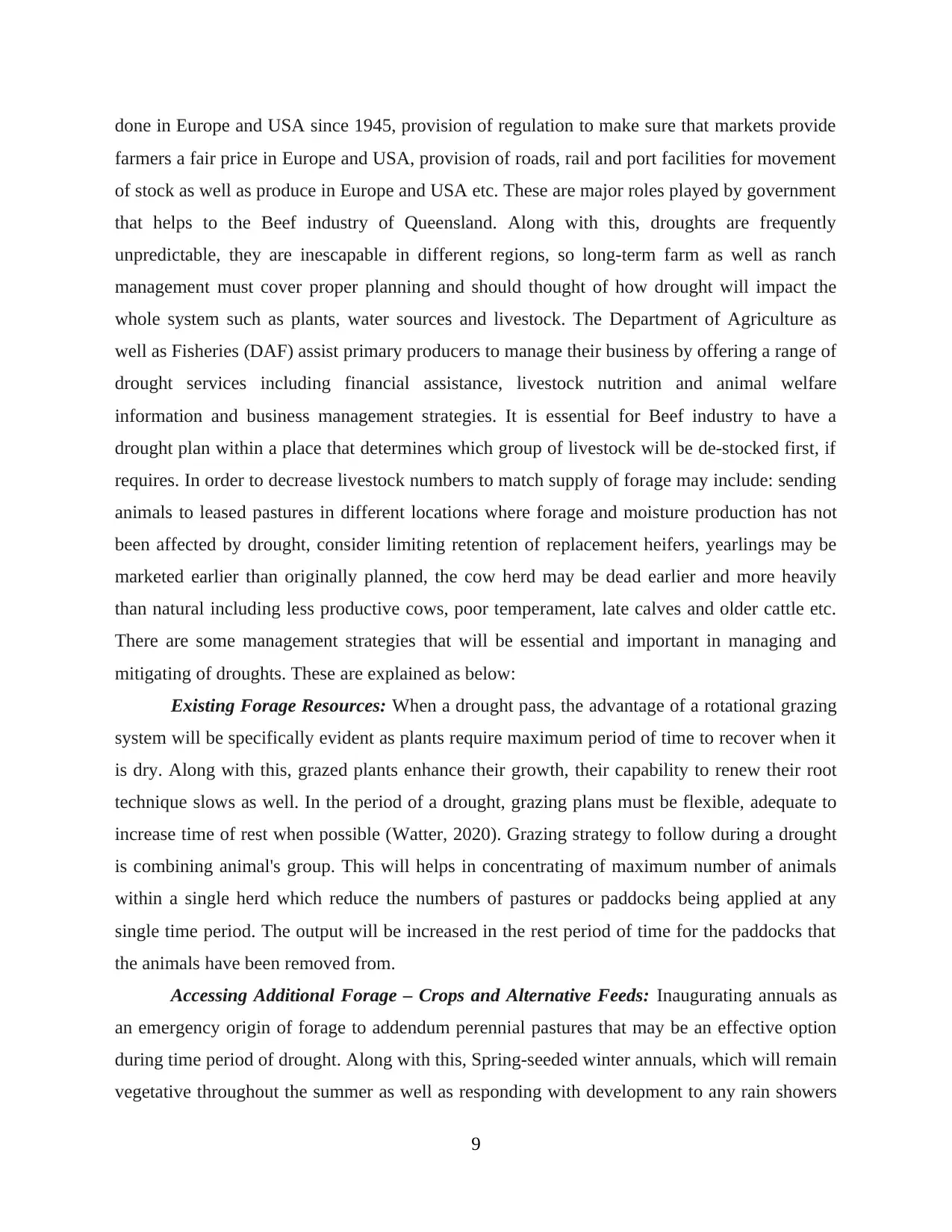
done in Europe and USA since 1945, provision of regulation to make sure that markets provide
farmers a fair price in Europe and USA, provision of roads, rail and port facilities for movement
of stock as well as produce in Europe and USA etc. These are major roles played by government
that helps to the Beef industry of Queensland. Along with this, droughts are frequently
unpredictable, they are inescapable in different regions, so long-term farm as well as ranch
management must cover proper planning and should thought of how drought will impact the
whole system such as plants, water sources and livestock. The Department of Agriculture as
well as Fisheries (DAF) assist primary producers to manage their business by offering a range of
drought services including financial assistance, livestock nutrition and animal welfare
information and business management strategies. It is essential for Beef industry to have a
drought plan within a place that determines which group of livestock will be de-stocked first, if
requires. In order to decrease livestock numbers to match supply of forage may include: sending
animals to leased pastures in different locations where forage and moisture production has not
been affected by drought, consider limiting retention of replacement heifers, yearlings may be
marketed earlier than originally planned, the cow herd may be dead earlier and more heavily
than natural including less productive cows, poor temperament, late calves and older cattle etc.
There are some management strategies that will be essential and important in managing and
mitigating of droughts. These are explained as below:
Existing Forage Resources: When a drought pass, the advantage of a rotational grazing
system will be specifically evident as plants require maximum period of time to recover when it
is dry. Along with this, grazed plants enhance their growth, their capability to renew their root
technique slows as well. In the period of a drought, grazing plans must be flexible, adequate to
increase time of rest when possible (Watter, 2020). Grazing strategy to follow during a drought
is combining animal's group. This will helps in concentrating of maximum number of animals
within a single herd which reduce the numbers of pastures or paddocks being applied at any
single time period. The output will be increased in the rest period of time for the paddocks that
the animals have been removed from.
Accessing Additional Forage – Crops and Alternative Feeds: Inaugurating annuals as
an emergency origin of forage to addendum perennial pastures that may be an effective option
during time period of drought. Along with this, Spring-seeded winter annuals, which will remain
vegetative throughout the summer as well as responding with development to any rain showers
9
farmers a fair price in Europe and USA, provision of roads, rail and port facilities for movement
of stock as well as produce in Europe and USA etc. These are major roles played by government
that helps to the Beef industry of Queensland. Along with this, droughts are frequently
unpredictable, they are inescapable in different regions, so long-term farm as well as ranch
management must cover proper planning and should thought of how drought will impact the
whole system such as plants, water sources and livestock. The Department of Agriculture as
well as Fisheries (DAF) assist primary producers to manage their business by offering a range of
drought services including financial assistance, livestock nutrition and animal welfare
information and business management strategies. It is essential for Beef industry to have a
drought plan within a place that determines which group of livestock will be de-stocked first, if
requires. In order to decrease livestock numbers to match supply of forage may include: sending
animals to leased pastures in different locations where forage and moisture production has not
been affected by drought, consider limiting retention of replacement heifers, yearlings may be
marketed earlier than originally planned, the cow herd may be dead earlier and more heavily
than natural including less productive cows, poor temperament, late calves and older cattle etc.
There are some management strategies that will be essential and important in managing and
mitigating of droughts. These are explained as below:
Existing Forage Resources: When a drought pass, the advantage of a rotational grazing
system will be specifically evident as plants require maximum period of time to recover when it
is dry. Along with this, grazed plants enhance their growth, their capability to renew their root
technique slows as well. In the period of a drought, grazing plans must be flexible, adequate to
increase time of rest when possible (Watter, 2020). Grazing strategy to follow during a drought
is combining animal's group. This will helps in concentrating of maximum number of animals
within a single herd which reduce the numbers of pastures or paddocks being applied at any
single time period. The output will be increased in the rest period of time for the paddocks that
the animals have been removed from.
Accessing Additional Forage – Crops and Alternative Feeds: Inaugurating annuals as
an emergency origin of forage to addendum perennial pastures that may be an effective option
during time period of drought. Along with this, Spring-seeded winter annuals, which will remain
vegetative throughout the summer as well as responding with development to any rain showers
9
⊘ This is a preview!⊘
Do you want full access?
Subscribe today to unlock all pages.

Trusted by 1+ million students worldwide
1 out of 23
Related Documents
Your All-in-One AI-Powered Toolkit for Academic Success.
+13062052269
info@desklib.com
Available 24*7 on WhatsApp / Email
![[object Object]](/_next/static/media/star-bottom.7253800d.svg)
Unlock your academic potential
Copyright © 2020–2025 A2Z Services. All Rights Reserved. Developed and managed by ZUCOL.





